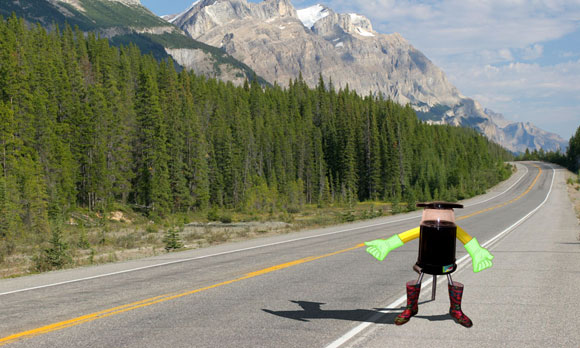

Photo courtesy of David Harris-Smith
HitchBOT - likely the world's first hitchhiking robot - is about to hit the road in its first solo trip across Canada.
The curious-looking robot with a plastic-pail torso, foam noodle arms, and rubber gloves for hands, is portable enough for anyone to pick-up on the highway. It also has the ability to strike up conversations with its fellow travellers.
Equipped with basic computer vision and a microphone to detect motion and speech, HitchBOT is able to converse with the people it meets using in-built speech-recognition software. 3G-network connectivity allows it to search the Web for suitable topics of conversation, as well as to share photos and messages of its adventures on social media. Internal GPS will also help researchers track its 4,480-kilometre trek from Halifax to Victoria that begins on July 27th.
Part artwork part social robotics experiment, the project involves students and professors from McMaster University, Ryerson University, and the University of Toronto. The goal is to help researchers better understand people’s relationship with smart technologies.
"Usually, we are concerned whether we can trust robots, e.g. as helpers in our homes. But this project takes it the other way around and asks: can robots trust human beings?” explained project lead Dr. David Harris-Smith, a professor in the Department of Communication Studies and Multimedia at McMaster University, in an interview with The Atlantic.
Dr. Harris and Ryerson professor Dr. Frauke Zeller conceived the idea of HitchBOT in 2013. Both are new researchers in GRAND.
Dr. Harris' GRAND research has mainly centred on the development and application of the macGRID Simulation Research Network. The robust simulation research platform for virtual worlds and mixed reality systems has formed a wide network of artists, researchers, institutions, and industry participants. Dr. Zeller is currently part of GRAND’s NEWS2 project, conducting cultural and communication studies for a CBC NewsWorld visualization and sonification project.
As GRAND researchers, Drs. Harris-Smith and Zeller also created HitchBOT’s “older brother” kulturBOT 1.0, a robotic art critic that attends exhibitions and produces tweets and captioned images for social media.
University of Toronto Computer Science professor Dr. Frank Rudzicz, a Computer Science Professor is another member of the HitchBOT team in GRAND. He was also a recipient of GRAND's Young Network Investigator Award in 2011. An expert in atypical speech and language both in people with physical and cognitive disorders, Dr. Rudzicz developed the software behind HitchBOT’s speech capabilities. His hope is that HitchBOT will shed light on how people and robost can interact through speech and language. The results will carry over to other work in robotics, including technology to aid people with dementia
"My research in GRAND has focused on the recognition of atypical speech and there are few things more atypical than a robot hitchhiking across Canada," he said. "HitchBOT is made possible only through networks like GRAND that bring together technologists, artists, and social scientists with interests in each other’s domains."
Likewise for Dr. Harris-Smith, the HitchBOT project has helped move forward research in other areas within GRAND such as inclusive media, speech recognition, virtual social interaction, digital storytelling, and social media.
“HitchBOT is a creative work that has developed as a result of the GRAND NCE and its mandate to connect researchers of diverse disciplinary backgrounds to work together on multidisciplinary projects. As an artistic work it promotes dialogue and public attention regarding critical issues addressed by GRAND themes.”
You can follow HitchBOT coast-to-coast on Twitter, Instagram, and Facebook.